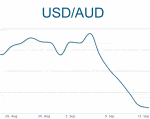The Australian dollar is weakening and should this continue, it could have implications for households considering going solar.
The Australian dollar broke below US90¢ for the first time in six months on Monday afternoon. According to the Sydney Morning Herald, the dollar hit an intraday low of US89.90¢ in late afternoon trade, and experts warned that “if a significant slide starts it could be difficult to unwind”.
Warnings last year that the days of the dollar being above parity are done and dusted appear to have proven correct. In April last year, the dollar was sitting as high as USD 105 cents; but it hasn’t reached parity since late May 2013. The dollar had reached as high as 93.77 cents early this month.
If the slide continues or the sub-90c position maintained, it will put increasing pressure on prices of a wide range of equipment imported into Australia – including solar panels and solar inverters. With margins on solar components often wafer-thin, there isn’t a lot of wiggle room these days and a difference of just a few percent can add hundreds to the final cost of installing a solar power system.
While solar equipment has been dropping in price generally due to competition and more efficient manufacturing, any differences in currency exchange can eat into those reductions.
The other, and larger, potential issue is the ongoing threat to solar subsidies as a result of the Renewable Energy Target review report. The report recommends the closure or rapid winding down of the Small-scale Renewable Energy Scheme (SRES). If the subsidy is lost, it will could add thousands onto the cost of solar power systems.
While the value of the Renewable Energy Target has far exceeded its cost and a major campaign in under way to save the RET, the Australian Government’s seemingly hostile nature towards renewables means all bets are off as to the ongoing security of subsidies for small scale solar.













































